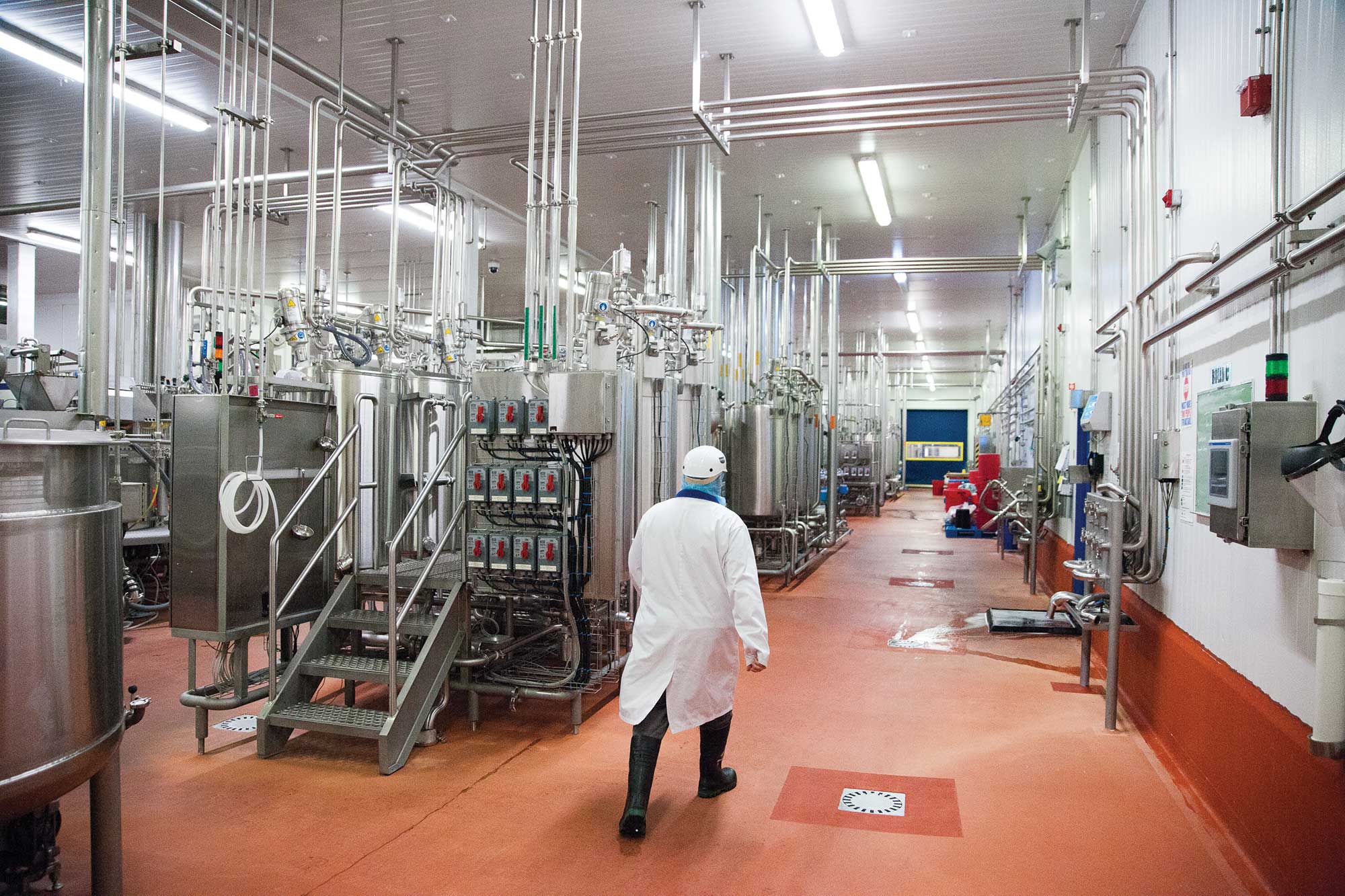Canadian Dairy: The Story of Three Ice Cream Processors
Dairy processors across the province are poised for growth and looking for opportunities to connect with restaurateurs. As Canadian consumers turn toward eating higher-fat dairy products, you’ll want to ensure the products and meals you’re bringing to market are what consumers are looking for in terms of quality, taste and versatility. Canadian dairy is one of the top two agricultural sectors in seven out of 10 Canadian provinces.
There are a wealth of opportunities for your foodservice operation to partner with dairy processors to create new demand for your menu offerings. Now is the time to capitalize on the dairy market segment. This is where Canadian ice cream processors come into play. We bring you three of their stories.
CHAPMAN’S
Chapman’s is the leading ice cream company in Canada by volume sold due in no small part to its dedication to the art and science of ice cream.
It doesn’t matter how good your art is if the science isn’t there” – Ashley Chapman, vice president and son of Chapman’s founders David and Penny Chapman.
Proudly Canadian, Chapman’s ice cream products are distributed across Canada from coast to coast. Owned and operated by the Chapman family since 1973 in Markdale, Ontario, Chapman’s was an early innovator in specialty products. Today they are an industry leader recognized for having some of the best, safest food processing facilities in the world. Chapman’s makes a wide variety of specialty products including its peanut/nut-free, no sugar added, lactose-free and gluten-free lines. Its global safety audits are consistently near perfect.

When you drive down Chapman’s Crescent in Markdale, Ontario, you’re told at the security gates that you cannot bring nuts onto the premises. As you drive further, you’ll see some buildings, one of which has the words NUT HOUSE sprawled across the top, where Chapman’s products containing nuts are processed (and only those nuts used in ice cream are permitted inside the strictly-controlled facility).
In another area of the grounds is the “Phoenix” building where the allergen-free, gluten-free specialty products are processed. No matter which facility you enter, there is a decontamination process—hygiene and cross-contamination protocols that are stringently followed by all staff and visitors. At every entry or exit are coveralls, gloves and boot wash stations, in addition to the boot wash stations you have already moved through, to ensure nothing is carried from one room to another on the bottoms of boots.
“No company invests more in the safety of their food product,” says Chapman. “We have the safest ice cream in the world. Not just in Canada but across the globe. We belong to an organization of 14 independent ice cream makers around the globe, so we compare ourselves with both domestic and international benchmarks. The Chapman’s plant is one of the most modern in the world. In a day where chefs can’t always feel totally comfortable about ingredients coming in, they certainly never have to worry about Chapman’s ice cream.”
The Chapman’s point of difference is incontrovertible. “We guarantee everything we do. That guarantee has existed since 1973 when my parents started the company. In 1999-2000, we took a big step to offer niche products. We put our commitment to those offerings as well. To do those things well for consumer safety, you have to become the best at procedures, policies and cleaning.”
Chapman’s mandate: developing products that every single Canadian can enjoy.
Contributing to the infrastructure of the community in which its operations are situated is also a priority. Chapman’s is a local dairy at scale—while its business has grown exponentially, the dairy facility is still located in small-town Ontario. As a community partner, Chapman’s has donated $2 million dollars to the new local school, $1 million to the local hospice facility, and has built a soccer complex for the area’s children. Chapman’s has also made significant infrastructure investments to curtail its environmental impact, including a state-of-the-art wastewater processing facility.
Knowing and understanding your brand is the key to success. “We are very simple compared to other companies. We don’t have lofty goals, we don’t have strict growth targets we must hit, or heads will roll. We’re pretty laid back in that it’s the essentials we focus on. Treating our employees well, making sure they’re happy in their jobs translates into better products. We steer clear of gimmicky trends. If we are going to embrace a trend, we aren’t going to do it for the short-term, but the long-term,” says Chapman proudly.
KAWARTHA DAIRY
This little cottage-country ice cream gem might be one of the most successful hyperlocal food stories in Canada. Kawartha Dairy celebrated its 80th anniversary in 2017. Distributed only within Ontario, its ice cream is the same as it was when they started making it in the 1950s.
Kawartha Dairy is still operated by the same family that started it back in the beginning. Although it has grown tremendously from its early days, it remains headquartered in Bobcaygeon, Ontario, where it was founded. Today, Kawartha Dairy operates some retail stores and services a wide range of wholesale customers, from retail outlets to foodservice establishments and, of course, ice cream parlours. Situated in a bountiful farming region, the dairy receives deliveries of fresh milk daily, most of which is from the local area and all of which is from Ontario farms.
The only changes made as time goes on have been improvements to some of the ingredients. Kawartha Dairy boasts real, old-fashioned ice cream.
Tom Legere is the marketing manager for Kawartha Dairy, and he says that “It’s the same ice cream as it has always been.” What is the Kawartha point of difference? “It’s one of the highest butterfat ice creams you can get in Ontario and a premium product.”
Legere suggests there is a spot in the marketplace for all different types of ice cream producers. There’s something for everyone. Kawartha Dairy has been interested in growth, but slow, controlled growth that never compromises customer service or the quality of its products. Kawartha has done the majority of its marketing by word of mouth.
The experience people had in discovering us and enjoying our ice cream [began] in cottage country. They would come back and tell people about it.”
Now Kawartha is distributed in supermarket chains, Costco, scoop shops and restaurants across Ontario.
Kawartha is exceptionally good at relationships within the industry. The company also provides custom production services to other food companies, using Kawartha Dairy’s expertise in the business to produce ice cream and other specialty dairy items to the exact specifications of these firms. The company has built local partnerships with foodservice establishments, other food processors and even a brewery. Muskoka Brewery and Kawartha Dairy collaborated to create a limited-edition, ice cream-inspired beer: The Salty Caramel Truffle, as well as a beer-infused ice cream: Pralines & Cream Ale.
It has also teamed up for well over 15 years as the supplier of ice cream to all Purdy’s chocolatiers across Ontario. Legere says that Purdy’s was a “great fit with high-quality chocolate.” Purdy’s is a western company out of British Columbia. Also a family-owned company, the two businesses found each other and have built a quietly successful relationship.
“If you like ice cream, there is a good chance you’re going to look for us,” says Legere. Kawartha Dairy is a small company that makes the most of its opportunities. It has just opened its very own distribution centre. “Keeping our distribution operations in-house will help with logistics. It ensures proper rotation of product and storage at proper temperatures.” This is part of the slow, steady, quality growth process that Legere referred to earlier. This build also helps to solidify its investment in the community of Bobcaygeon.
As far as advice for foodservice operators goes, Legere wants restaurateurs to understand how important it is to get branding on the menu. Don’t leave money on the table by serving generic, poor-quality ice cream. Invest in profitable partnerships with companies like Kawartha Dairy, brand your menu offerings that use ice cream and tell the story of the product and the partnership. Make your ice cream offerings the best around, build on them, be creative and watch your bottom line grow. Says Legere, “Supporting other local businesses. This is who we are.”
NESTLÉ
Nestlé is a global company with a local presence. Nestlé is the world’s largest food and beverage company with over 2,000 brands. Founded in 1866 by Henri Nestlé of Switzerland. The Germany-born pharmacist launched his farine lactée (flour with milk) in which he combined cow’s milk, wheat flour and sugar for consumption by infants who could not breastfeed to tackle high infant mortality rates. It was around this time that Nestlé started using the iconic “nest” logo.
Manufacturing began in Canada in 1918 with the purchase of a small milk factory in Chesterville, Ontario. Four years later, the company was incorporated as Nestlé’s Food Company of Canada Limited. Nestlé in Canada is headquartered in London, Ontario. The London plant produces the national supply of Nestlé ice cream products, including a recently announced expansion plan—a major $51.5 million expansion to continue to create jobs and supply the Canadian demand for its products. Nestlé is the largest purchaser of Canadian dairy. In 2016, Nestlé Canada purchased dairy products totalling over $38 million from Canadian dairy farmers.
Jayne Payette is the business executive officer for ice cream with Nestlé Canada. Her colleague Joseph D’Andrea is the business executive officer for Nestlé Professional. Nestlé may be a global company, but its Canadian operations are looking to support the London, Ontario region where its factory produces all of its ice cream for Canada, all using local dairy.
DRUMSTICK holds a 70 per cent share of cone sales in Canada, and this is still one of the areas where the company has increased its operations with a whole new line. As the number one cone brand in Canada with over 54 million cones made in Canada each year—if all the DRUMSTICKs made in one year were laid out in a line, they would span Canada coast to coast 1.5 times!
When it comes to ice cream, Nestlé never stops innovating.
For us, it’s about staying closely in tune with what consumers are demanding. It’s about small treats and small pleasures in our lives and [being] willing to indulge in order to have great experiences,” says Payette.
“Where we have decadence, we’re also very focused on nutritional, health and wellness.” Payette uses the portion-control serving option for DRUMSTICK as an example with individually-wrapped units that are under 100 calories
 Nestlé has also launched GOODNORTH ice milk in 475ml tubs. A decadent but nutritional product that doesn’t compromise on the quality of its ingredients, but which is less sweet, with higher protein, less fat, has fewer calories per serving and contains no artificial flavours, colours or sweeteners.
Nestlé has also launched GOODNORTH ice milk in 475ml tubs. A decadent but nutritional product that doesn’t compromise on the quality of its ingredients, but which is less sweet, with higher protein, less fat, has fewer calories per serving and contains no artificial flavours, colours or sweeteners.
On the flipside, Canadian milk products are the foundation of Nestlé brands like Häagen-Dazs: known for delivering a first class, indulgent experience.
Working with and for Canadian foodservice
Nestlé Canada wants to support chefs and restaurateurs, particularly independent foodservice operators. Independents are “suffering today, and they need to look toward more diverse offerings,” says D’Andrea. Get great ice cream on your menus. Ice cream can be mixed into shakes, smoothies, coffee-based offerings, desserts, entrées and cocktails. There’s a lot of business there for the taking with relatively little cost and great value for operators. Exploit ice cream’s versatility for your operation (think outside the cone!) to drive more sales for profitability. Leverage the brands that consumers love. Nestlé collaborates with foodservice chains and independents alike, working with companies like A&W and Cara on dessert solutions while being equally focused on demonstrating to smaller operators the most successful ways to integrate the ice cream component with your business.
Ice cream enjoys tremendous consumer interest, and the young, hip consumer is a big target. “We opened a promotional Bär Häagen-Dazs pop-up in 2017 focused on a super decadent experience,” says D’Andrea. Consumers could experience a flight of ice cream, and the concept was wildly popular. The pop up also offered a range of ice cream-based cocktails, and the alcohol-infused dessert cocktails certainly demonstrated their menu-boosting power. Says D’Andrea, consumers today want to have exceptional food and beverage experiences that are also totally “instagrammable,” and they’re willing to pay a premium for those experiences.
Nestlé continues to innovate around education too, working with industry trainers and chefs on successfully working with ice cream. With a focus on turnkey solutions that incorporate easy-to-follow steps for enhancing your offerings while making a bit of theatre and creating experiences for the consumer. At Nestlé Canada, D’Andrea tells us that Canadian chefs are the cherry on top of the industry. We couldn’t agree more.









